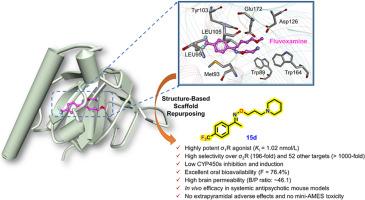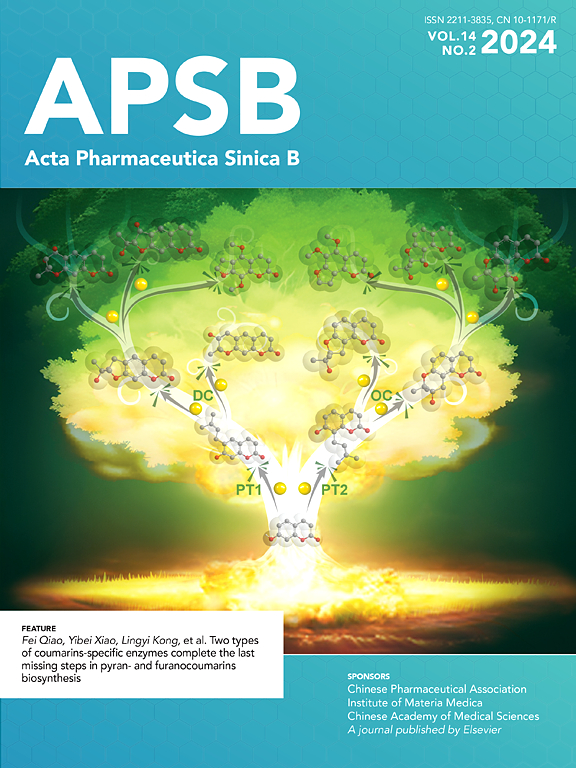一种用于抗精神病药物开发的新型高选择性sigma-1受体激动剂的发现和概念验证研究
IF 14.6
1区 医学
Q1 PHARMACOLOGY & PHARMACY
引用次数: 0
摘要
Sigma-1受体(σ1R)已成为中枢神经系统(CNS)疾病药物发现的热点。合成了一系列新的1-苯基比1- 1- 1- O-(2-氨基乙基)肟衍生物。体外生物学评价表明,1a、14a、15d和16d是高亲和力(Ki < 4 nmol/L)和选择性的σ1R激动剂。其中,15d代谢稳定,对σ1R和其他52个人体靶标具有较高的选择性。除了低CYP450抑制和诱导外,15d还具有高脑通透性和良好的口服生物利用度。重要的是,15d在实验动物模型中显示出有效的抗精神病效力,特别是在缓解阴性症状和改善认知障碍方面,这两者都是精神分裂症治疗的主要挑战。此外,15d没有产生明显的锥体外系症状,与目前的抗精神病药物相比,显示出优越的药理学特征。在机制上,15d抑制GSK3β,增强前额叶BDNF表达和锥体神经元的兴奋性突触传递。总的来说,这些体内概念验证的发现提供了大量的实验证据,证明调节σ1R代表了一种潜在的治疗精神分裂症的新方法。这种新的化学实体及其有利的药物样和15d的药理学特征使其成为治疗精神分裂症的有希望的候选者。本文章由计算机程序翻译,如有差异,请以英文原文为准。

Discovery and proof-of-concept study of a novel highly selective sigma-1 receptor agonist for antipsychotic drug development
Sigma-1 receptor (σ1R) has become a focus point of drug discovery for central nervous system (CNS) diseases. A series of novel 1-phenylethan-1-one O-(2-aminoethyl) oxime derivatives were synthesized. In vitro biological evaluation led to the identification of 1a, 14a, 15d and 16d as the most high-affinity (Ki < 4 nmol/L) and selective σ1R agonists. Among these, 15d, the most metabolically stable derivative exhibited high selectivity for σ1R in relation to σ2R and 52 other human targets. In addition to low CYP450 inhibition and induction, 15d also exhibited high brain permeability and excellent oral bioavailability. Importantly, 15d demonstrated effective antipsychotic potency, particularly for alleviating negative symptoms and improving cognitive impairment in experimental animal models, both of which are major challenges for schizophrenia treatment. Moreover, 15d produced no significant extrapyramidal symptoms, exhibiting superior pharmacological profiles in relation to current antipsychotic drugs. Mechanistically, 15d inhibited GSK3β and enhanced prefrontal BDNF expression and excitatory synaptic transmission in pyramidal neurons. Collectively, these in vivo proof-of-concept findings provide substantial experimental evidence to demonstrate that modulating σ1R represents a potential new therapeutic approach for schizophrenia. The novel chemical entity along with its favorable drug-like and pharmacological profile of 15d renders it a promising candidate for treating schizophrenia.
求助全文
通过发布文献求助,成功后即可免费获取论文全文。
去求助
来源期刊

Acta Pharmaceutica Sinica. B
Pharmacology, Toxicology and Pharmaceutics-General Pharmacology, Toxicology and Pharmaceutics
CiteScore
22.40
自引率
5.50%
发文量
1051
审稿时长
19 weeks
期刊介绍:
The Journal of the Institute of Materia Medica, Chinese Academy of Medical Sciences, and the Chinese Pharmaceutical Association oversees the peer review process for Acta Pharmaceutica Sinica. B (APSB).
Published monthly in English, APSB is dedicated to disseminating significant original research articles, rapid communications, and high-quality reviews that highlight recent advances across various pharmaceutical sciences domains. These encompass pharmacology, pharmaceutics, medicinal chemistry, natural products, pharmacognosy, pharmaceutical analysis, and pharmacokinetics.
A part of the Acta Pharmaceutica Sinica series, established in 1953 and indexed in prominent databases like Chemical Abstracts, Index Medicus, SciFinder Scholar, Biological Abstracts, International Pharmaceutical Abstracts, Cambridge Scientific Abstracts, and Current Bibliography on Science and Technology, APSB is sponsored by the Institute of Materia Medica, Chinese Academy of Medical Sciences, and the Chinese Pharmaceutical Association. Its production and hosting are facilitated by Elsevier B.V. This collaborative effort ensures APSB's commitment to delivering valuable contributions to the pharmaceutical sciences community.
 求助内容:
求助内容: 应助结果提醒方式:
应助结果提醒方式:


